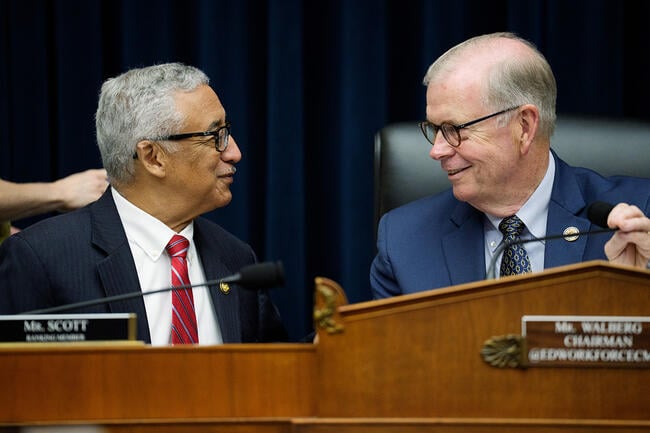You have /5 articles left.
Sign up for a free account or log in.

Rep. Tim Walberg (right), the chair of the committee, has nine colleges in his Michigan district, while Rep. Bobby Scott, a Virginia Democrat, has 11.
Andrew Harnik/Getty Images
Congress is eyeing significant changes to higher education policy, and as concerns grow about those proposals, college and university presidents are ramping up their lobbying efforts on Capitol Hill. And often, the first person they call is their local representative.
It’s these House lawmakers who are likely most familiar with the role colleges and universities play in their communities—from supporting the workforce to boosting the local economy. So when a college leader makes a call, lawmakers tend to listen. In some cases, they may even go on to specifically advocate against policies that would hurt an institution in their district.
But not all institutions have a lawmaker seated on the committee that focuses most on higher ed. This can always be a challenge for institutions, but it is particularly the case as Congress tries to pass a budget megabill, known as reconciliation, that could lead to major spending cuts and higher endowment taxes to help fund President Donald Trump’s policy priorities. The proposed changes from the House Education and Workforce Committee, which were passed in May, could lead to sweeping changes to how students pay for college and introduce new measures to hold colleges accountable for students’ employment rates and income levels after graduating. Now, the Senate is working on its own version.
And the House committee is eyeing more changes to how institutions operate, beyond those included in the reconciliation bill. This week, those same lawmakers will mark up a bill to bar accreditors from requiring institutions to follow standards related to diversity, equity and inclusion. They also will likely have a say in whether and how the Trump administration closes the Department of Education and have opened multiple investigations into how some colleges are handling reports of antisemitism.
In light of this, Inside Higher Ed wanted to learn more about the committee’s members and the colleges they represent.
The committee is made up of 36 representatives from 24 states. Together, they represent about 304 colleges, according to an Inside Higher Ed analysis of data from the American Council on Education.
ACE researchers initially determined which colleges are included in which congressional districts based on a combination of data collected from the Integrated Postsecondary Education Data System and the House of Representatives website. We then pulled out the colleges in districts represented on the education committee and broke them down by sector, geographic location and political party.
Here are five charts that break down Inside Higher Ed’s findings.
Colleges Across the Country
Over all, the committee’s members represent 304 colleges and universities, or about 8 percent of the nation’s 3,842 institutions as listed in ACE’s data set. Although members come from 24 of the 50 states, their districts don’t always represent many of their state’s institutions.
For example, the one Texas representative on the committee represents five of the state’s 241 institutions. And even in a state like North Carolina, the three representatives on the committee represent 29 out of 137 total institutions.
Republicans Represent the Majority
The Committee on Education and Workforce is currently made up of 20 Republicans and 16 Democrats. With a substantive majority like this, it makes sense that the conservatives represent a higher number of institutions over all. But they also represent slightly more colleges on an individual level. While the Democrats on average represent eight institutions per person, the Republicans represent 8.8 each.
This means that in general there are more colleges located in districts represented by Republicans.
Variety of Institutions in the Mix
Like the Trump administration, many Republicans on the Hill have declared higher education institutions, particularly wealthy private liberal arts ones, the enemy. Meanwhile, they tend to advocate for private for-profit institutions like trade schools, arguing that their short-term programs are more aligned with the modern skills-based job market and that they are more focused on student outcomes like employment rates and return on investment.
But conservative lawmakers are actually less likely than Democrats to represent a for-profit institution. Instead, they tend to represent more private nonprofit and public institutions. Across the board, lawmakers tend to represent more four-year institutions than community and technical colleges.
Aside from economic models, higher education institutions are also often broken down based on the types of students they serve and their mission with categories such as historically Black colleges and universities, Hispanic-serving institutions and land-grant universities. Several of the colleges represented by the committee members fall into one or more of those categories, including 10 of the country’s 99 HBCUs.
Lawmaker by Lawmaker
When looking at the list of colleges by individual lawmakers, representation also varies. Some lawmakers have more than a dozen institutions in their district, while others have just one.
The committee chair, Rep. Tim Walberg, a Michigan Republican, fell in the middle of the pack with nine institutions in his district. Ranking member Rep. Bobby Scott, a Virginia Democrat, represents 11 colleges and universities.
Other key voices on the committee, including former chair Rep. Virginia Foxx, a North Carolina Republican; Rep. Suzanne Bonamici, an Oregon Democrat; and Rep. Elise Stefanik, a New York Republican, were also among the lawmakers to represent the most institutions.
To search for your institution, see the full database below.




